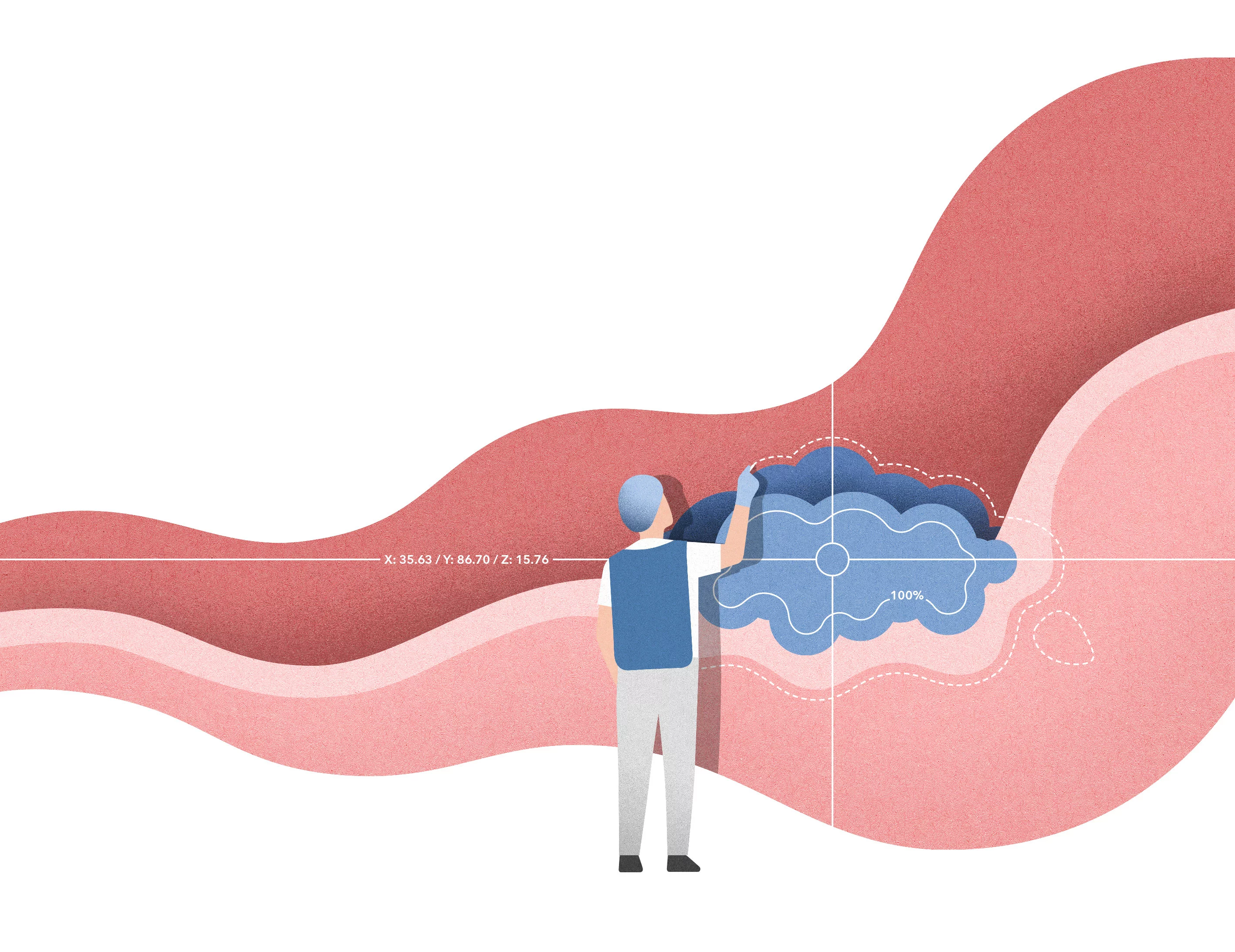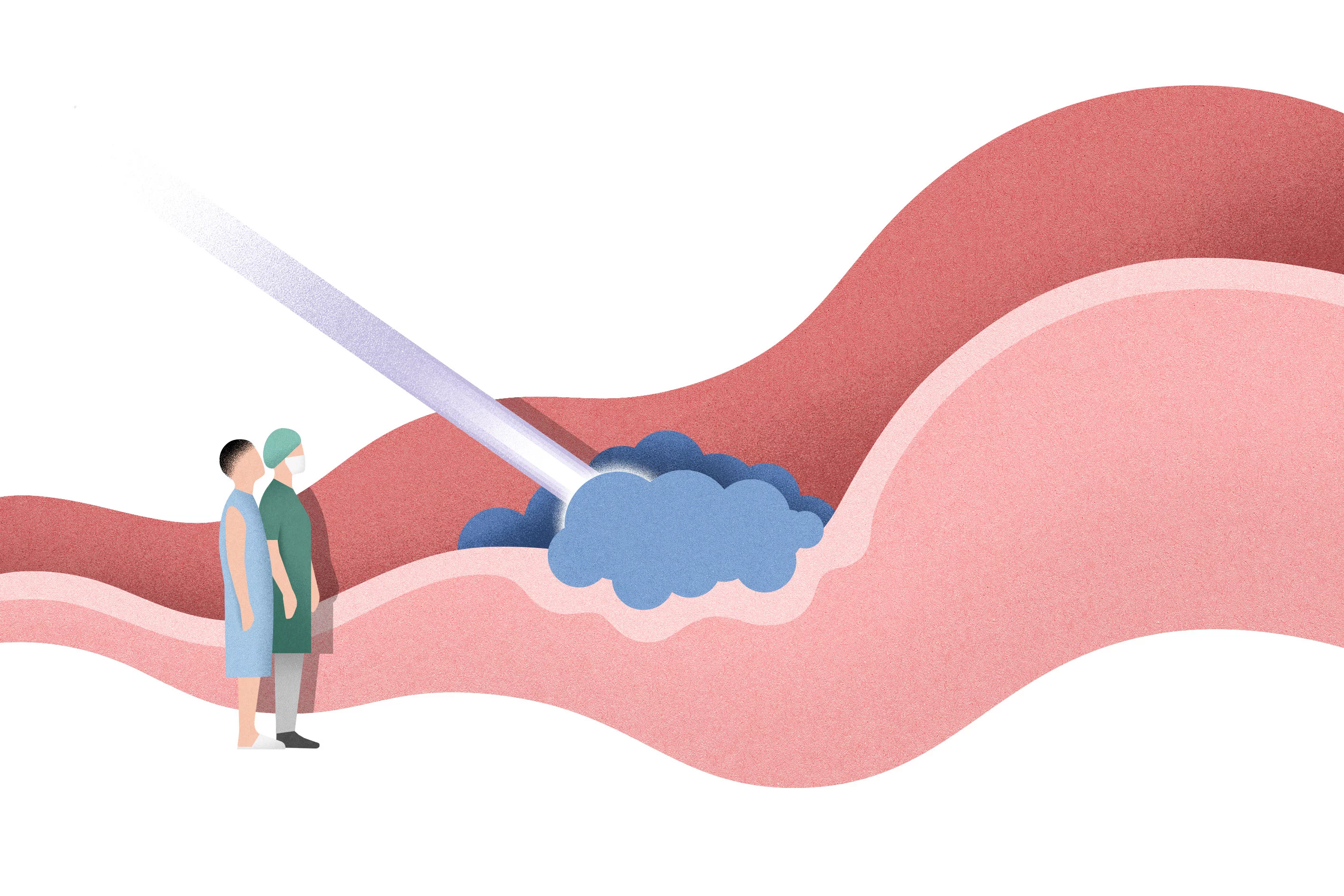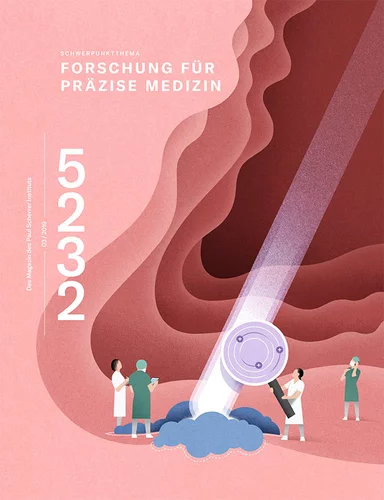At the Paul Scherrer Institute PSI, cancer patients receive a treatment that is unique in Switzerland. Bombardment with protons wipes out cancer cells – and does so more precisely than with any other form of irradiation. This expands the options for treatment in complicated cases, especially in children.
Olga Jose activates the intercom. As the radiology specialist fixes her eyes on one of the many screens, she asks, "Can we have the beam, please?" On one monitor, she sees the image taken by a camera in the therapy room just a few metres away. There, at one of the treatment stations for proton therapy at PSI, the so-called Gantry 3, a young man lies quite calmly on a patient couch. He is awaiting irradiation. After learning that the required beam can be triggered, Jose presses the irradiation button.
Fifty metres away, behind Gantry 3, positively charged particles called protons begin their journey to the patient. At a speed of up to 175,000 kilometres per second – nearly two-thirds the speed of light – they fly towards the young man. They penetrate skin and tissue until they reach the end of their rapid flight: the cancer cells that threaten the patient's life.
The pencil-thin proton beam navigates to its target with the utmost precision. With just a deviation of less than a millimetre, it could hit adjacent healthy tissue. "Compared to other radiation methods, for example with photons, this is a very gentle treatment", says Barbara Bachtiary, a radiooncologist at PSI.
Many members of the PSI staff have contributed their share towards this tour de force of precision. Physicians, physicists, and technicians work every day at the Centre for Proton Therapy CPT to direct protons as precisely as possible into tumours and destroy them. In doing so, they build on their respective expertise, the right infrastructure, and many years of experience. Here in Villigen, after all, cancer patients have been treated with custom-tailored proton therapy for 35 years. Custom-tailored means: the right duration, intensity, and frequency of irradiation in the right place. With such customised radiotherapy, the specialists at PSI have already helped more than 8,000 cancer patients beat their illness.
Diagnosis: Cancer
The young patient – let's call him Noah Schmid – has also come to PSI for this technologically advanced method of cancer irradiation.
The first symptoms were quite unspecific, he recalls: a runny nose and a slight headache. When no medication helped, he went to the doctor. After just a few examinations, it was clear: a rare cancerous tumour had spread out in his sinuses and pharynx, proliferated along the olfactory nerves to the brain, and attacked one lymph node after another, all the way down to his neck. No question: The tumour had to come out. But due to the proximity to the optic nerves, the surgeons were only allowed to operate with great caution and could not remove all of the malignant cells. This was followed by chemotherapy and a request to the Paul Scherrer Institute. The doctors knew: PSI has proton therapy, and that can help Noah Schmid.
"Cancer cells often grow very close to sensitive structures such as the optic nerve, inner ear, or spinal cord", explains Barbara Bachtiary. "Conventional radiotherapy would also affect these structures and cause side-effects." Proton therapy, on the other hand, is the most accurate of all irradiation methods against cancer and the one that can deliver the most precise dose. This protects healthy tissue. Therefore, doctors use this form of irradiation especially for tumours in the head and neck area, where often a few millimetres decide whether a patient, for example, loses eyesight or hearing. Noah Schmid also fears for his eyesight. His voice gets quiet as Bachtiary cautiously explains how close the proton beam will come to the optic nerve: five millimetres. The physician wants to maintain this safety zone at all costs.
To plan the irradiation as precisely as possible, the team first produces up-to-date layered images of the head and neck. For this purpose, the CPT has its own major medical devices such as computed tomography (CT) and magnetic resonance imaging (MRI) systems. These devices provide highly detailed images that show the head and neck in layers less than one millimetre thick. In the black-and-white images, Bachtiary recognises the bone structures and soft tissues such as strands of nerves. On the monitor, she uses thin coloured lines to trace the contours of sensitive structures and tumour remnants. It takes practice, but the physician has seen many thousands of such images in her life.
These images then form the basis for the treatment and the most important tool for the irradiation plan: Red hatching indicates the area the protons should strike with the greatest strength, that is, cancerous tissue and affected lymph nodes. A blue region next to that shows the areas that may still contain tumour cells and thus should also be irradiated with a strong dose. Alongside follow yellow areas where vulnerable structures are located and only a weak proton dose is permitted to strike. Finally, some cancer cell clusters along the blood and lymph vessels around the neck are framed in green.
Safety through teamwork
Already in the run-up to the irradiation planning, the physicians at PSI have informed the doctors who had previously treated him.
"We highly value the close collaboration with the physicians of the referring clinics and appreciate the professional exchange with all of the Swiss university and cantonal hospitals. In the past three years, most patients have been assigned to us from the University Hospital of Zurich, the Inselspital Bern, and the cantonal hospitals of St. Gallen and Aarau", says Damien Charles Weber, head and chairman of the CPT.
We highly value the close collaboration with the physicians of the referring clinics.
With Noah Schmid, it took almost three weeks before the treatment plan was worked out and he received his first irradiation. Bachtiary had explained the therapy to him in detail: During the treatment, a bundled beam of protons damages the DNA in his cancer cells, causing them to lose their ability to divide and proliferate, so that they die off. The crucial advantage of irradiation with protons: The fast-moving, heavy particles can be steered and slowed down to ensure that they deposit their maximum energy only in the tumour. They lose very little energy along the way and stop exactly in the tumour tissue, which in turn protects healthy tissue in front of and behind the tumour. Thus the success of proton therapy ultimately depends on irradiating the tumour tissue as precisely as possible.
Patient Schmid knows that he has to come to PSI every day for seven weeks and to lie as motionless as possible on the Gantry 3 treatment table. Although a single irradiation may be over in one to two minutes, with repositioning of the patient, a single round of irradiation may take more than an hour.
Just don't move
But before it starts, Schmid has to patiently submit to the fitting of a cushion and a plastic head mask by radiology specialist Olga Jose. Both are fastened with snaps to the treatment couch in the gantry. "For some patients, it is uncomfortable if they can't move their head and face during irradiation", Jose explains. "The mask helps us to position it exactly the same every day of treatment over several weeks." Nevertheless, before the first irradiation, it still takes half an hour before the patient's head, neck, and shoulders are in exactly the same place as the irradiation position given in the planning images. Jose and Bachtiary check the match again together.
The radiology specialist moves the gantry to the first irradiation position for the present treatment, then leaves the therapy room and goes to the control room, where she can start the procedure.
Keeping safety in view
Here, 19 monitors show images from cameras in the treatment room, the path of the proton beam, the functionality of the safety systems, and much more. Especially important: the irradiation plan. Jose looks attentively at one screen after another. She checks the correct position and the order of the irradiation fields, and she looks to see if the patient is lying still. Everything seems OK. The machinery that ensures a proper irradiation of the patient is working smoothly.
The patient's head and neck are irradiated from four different directions. Therefore, the gantry or its irradiation head has to be turned around the patient. Hidden behind a white wall, two ten-horsepower electric motors are used to move the enormous rotating body of the 220-ton gantry.
Irradiation technology developed at PSI
In the irradiation room, not a sound betrays the fact that protons are now penetrating Noah Schmid's body at two-thirds the speed of light and are abruptly stopping in the tumour. Or how, when they come to a complete stop, they give off all of their energy and thus achieve their maximum effect. After this energy release, called the Bragg peak, no more radiation is delivered. This special physical property of the protons is at the heart of the spot-scanning technique developed here at PSI more than 20 years ago. Damien Weber: "This method helped proton therapy achieve a worldwide breakthrough, because it made it possible to treat patients in a timely manner and to precisely irradiate irregularly shaped tumours." In the spot-scanning technique, the pencil-thin proton beam scans the tumour back to front, level by level, and row by row: first the lowest layer of the tumour and then the next higher, and so forth. Without the precision achievable through this technique, patients like Noah Schmid would only have a small chance of successful treatment. The same goes for children.
"In children, sensitive organs and structures are very close to each other. Their cells still have many cell divisions ahead of them, and thus decades to form mutations and to degenerate. That's why, during childhood, their cells should have as little exposure as possible to ionising radiation, which represents an extra risk. In addition, children can tolerate only a low dose of radiation", Weber explains. "When children have cancer, the much more precisely administered proton therapy is better for them than conventional photon radiation therapy. Photon beams cannot be focused so well because they don't release their energy with the same pinpoint precision as protons. That's why they often cause more damage to tissues in front of and behind tumours." The team at CPT has considerable experience in proton irradiation for the smallest cancer patients: With the support of pediatricians and pediatric anaesthetists, more than 500 children have been treated here, most of them according to precisely defined treatment protocols within the framework of international studies.
Aftercare for the patients' well-being
All important information on the treatment and well-being of patients small and large is meticulously collected in a database. Ulrike Kliebsch, who is responsible for patient studies at the CPT, says: "We regularly conduct studies on the efficacy of our therapy. In addition, children are included in the central children's cancer registry of Switzerland. This allows later conclusions about the most effective radiation parameters, any side-effects, and the quality of life. Tumours in children are very rare, and you want to know as much as possible about them."
When a patient has finished his or her radiation treatment, the first check-up takes place after eight to twelve weeks; further check-ups are usually scheduled every six months or annually. This aftercare is particularly close to the heart for all members of the CPT. Some patients later send postcards and thank-you letters or come back to visit in person, healthy and fit. That is the most beautiful thing for the CPT team.
Noah Schmid has his first irradiation behind him. The mask is removed, and he stretches himself. Lying motionless was strenuous. Bachtiary and Jose shake hands with him and say goodbye. Until the next day.
Text: Sabine Goldhahn
Further information
- See also the interview with Damien Weber, head and chief physician of the Center for Proton Therapy (CPT): "It's important to keep doing research"



